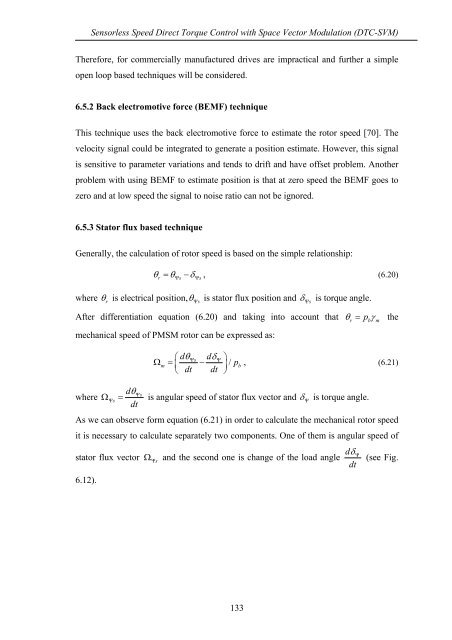Direct Torque Control with Space Vector Modulation (DTC-SVM) of ...
Direct Torque Control with Space Vector Modulation (DTC-SVM) of ...
Direct Torque Control with Space Vector Modulation (DTC-SVM) of ...
You also want an ePaper? Increase the reach of your titles
YUMPU automatically turns print PDFs into web optimized ePapers that Google loves.
Sensorless Speed <strong>Direct</strong> <strong>Torque</strong> <strong>Control</strong> <strong>with</strong> <strong>Space</strong> <strong>Vector</strong> <strong>Modulation</strong> (<strong>DTC</strong>-<strong>SVM</strong>)<br />
Therefore, for commercially manufactured drives are impractical and further a simple<br />
open loop based techniques will be considered.<br />
6.5.2 Back electromotive force (BEMF) technique<br />
This technique uses the back electromotive force to estimate the rotor speed [70]. The<br />
velocity signal could be integrated to generate a position estimate. However, this signal<br />
is sensitive to parameter variations and tends to drift and have <strong>of</strong>fset problem. Another<br />
problem <strong>with</strong> using BEMF to estimate position is that at zero speed the BEMF goes to<br />
zero and at low speed the signal to noise ratio can not be ignored.<br />
6.5.3 Stator flux based technique<br />
Generally, the calculation <strong>of</strong> rotor speed is based on the simple relationship:<br />
θ = θ − δ , (6.20)<br />
r Ψs Ψs<br />
where θ<br />
r<br />
is electrical position, θ Ψ s<br />
is stator flux position and δ Ψ s<br />
is torque angle.<br />
After differentiation equation (6.20) and taking into account that θ r<br />
= p b<br />
γ m<br />
the<br />
mechanical speed <strong>of</strong> PMSM rotor can be expressed as:<br />
⎛dθ<br />
⎜<br />
⎝ dt<br />
Ψs<br />
Ω<br />
m<br />
= −<br />
dδΨ<br />
⎞<br />
⎟/<br />
pb<br />
, (6.21)<br />
dt ⎠<br />
dθ s<br />
where Ω Ψ<br />
Ψs<br />
= is angular speed <strong>of</strong> stator flux vector and δ Ψ<br />
is torque angle.<br />
dt<br />
As we can observe form equation (6.21) in order to calculate the mechanical rotor speed<br />
it is necessary to calculate separately two components. One <strong>of</strong> them is angular speed <strong>of</strong><br />
stator flux vector Ω<br />
Ψs<br />
and the second one is change <strong>of</strong> the load angle d δ Ψ (see Fig.<br />
dt<br />
6.12).<br />
133















![[TCP] Opis układu - Instytut Sterowania i Elektroniki Przemysłowej ...](https://img.yumpu.com/23535443/1/184x260/tcp-opis-ukladu-instytut-sterowania-i-elektroniki-przemyslowej-.jpg?quality=85)
